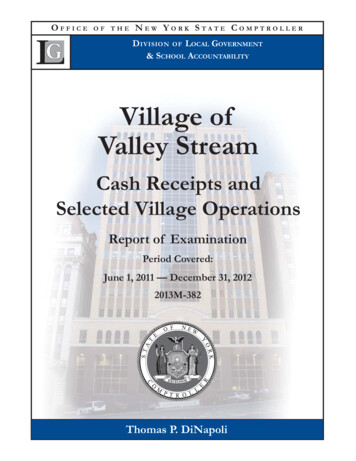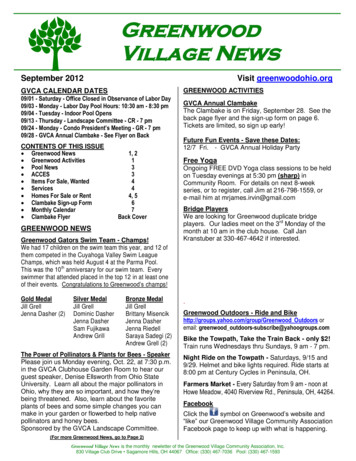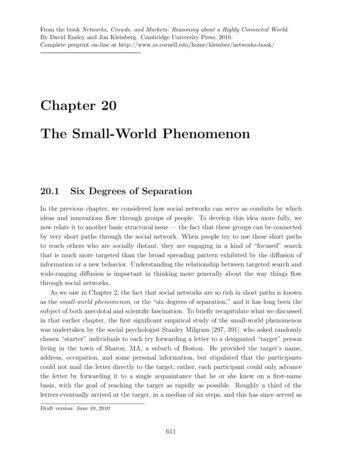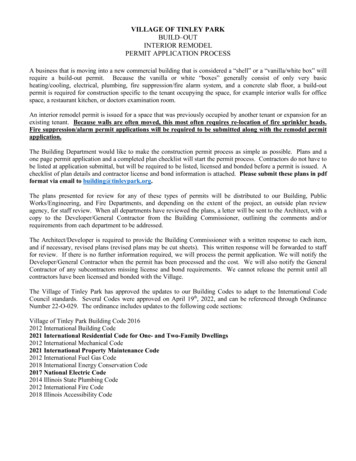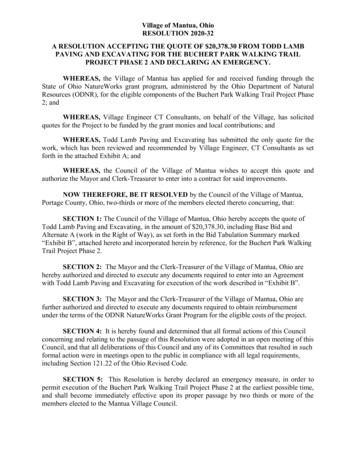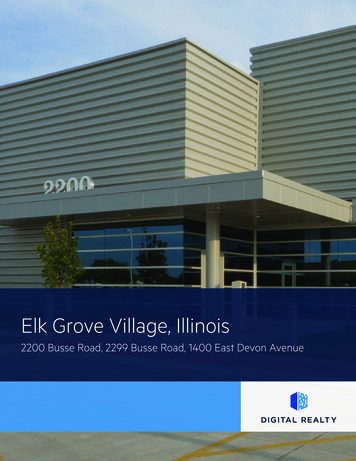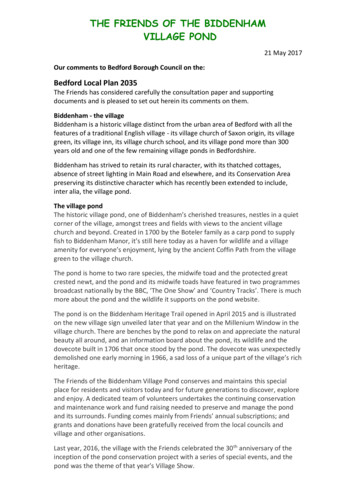
Transcription
THE FRIENDS OF THE BIDDENHAMVILLAGE POND21 May 2017Our comments to Bedford Borough Council on the:Bedford Local Plan 2035The Friends has considered carefully the consultation paper and supportingdocuments and is pleased to set out herein its comments on them.Biddenham - the villageBiddenham is a historic village distinct from the urban area of Bedford with all thefeatures of a traditional English village - its village church of Saxon origin, its villagegreen, its village inn, its village church school, and its village pond more than 300years old and one of the few remaining village ponds in Bedfordshire.Biddenham has strived to retain its rural character, with its thatched cottages,absence of street lighting in Main Road and elsewhere, and its Conservation Areapreserving its distinctive character which has recently been extended to include,inter alia, the village pond.The village pondThe historic village pond, one of Biddenham’s cherished treasures, nestles in a quietcorner of the village, amongst trees and fields with views to the ancient villagechurch and beyond. Created in 1700 by the Boteler family as a carp pond to supplyfish to Biddenham Manor, it’s still here today as a haven for wildlife and a villageamenity for everyone’s enjoyment, lying by the ancient Coffin Path from the villagegreen to the village church.The pond is home to two rare species, the midwife toad and the protected greatcrested newt, and the pond and its midwife toads have featured in two programmesbroadcast nationally by the BBC, ‘The One Show’ and ‘Country Tracks’. There is muchmore about the pond and the wildlife it supports on the pond website.The pond is on the Biddenham Heritage Trail opened in April 2015 and is illustratedon the new village sign unveiled later that year and on the Millenium Window in thevillage church. There are benches by the pond to relax on and appreciate the naturalbeauty all around, and an information board about the pond, its wildlife and thedovecote built in 1706 that once stood by the pond. The dovecote was unexpectedlydemolished one early morning in 1966, a sad loss of a unique part of the village’s richheritage.The Friends of the Biddenham Village Pond conserves and maintains this specialplace for residents and visitors today and for future generations to discover, exploreand enjoy. A dedicated team of volunteers undertakes the continuing conservationand maintenance work and fund raising needed to preserve and manage the pondand its surrounds. Funding comes mainly from Friends’ annual subscriptions; andgrants and donations have been gratefully received from the local councils andvillage and other organisations.Last year, 2016, the village with the Friends celebrated the 30th anniversary of theinception of the pond conservation project with a series of special events, and thepond was the theme of that year’s Village Show.
The Friends welcomes visits to the pond by schools and youth groups to make use ofthis valuable local resource for projects and studies across the curriculum. The pondis currently part of a national pond monitoring project being run by the FreshwaterHabitats Trust, and has been the subject of surveys by the Bedfordshire Reptile andAmphibian Group and the Bedfordshire Invertebrate Group.Significantly, the pond is not served by streams or springs and relies on precipitationand run off from adjacent fields for its water, and importantly the entire areasurrounding the pond is currently wildlife friendly.The village pond, looking towards the field to the north proposed in theLocal Plan 2035 for inclusion as suitable, available and achievable for development(there are more pictures in the Gallery in the Appendix to this response document)Consultation plan proposals – causes for concernIn the Borough Council’s Consultation Paper an area of land off Gold Lane,Biddenham, and within sites 29 and 691 is shown as a potential development area atthis stage: that area of land is not immediately adjacent to the village pond (see Map 1below). But in a supporting document, the current draft Strategic Housing andEmployment Land Availability Assessment (SHELAA), the whole of the land in sites 29and 691 is shown as being suitable, available and achievable for development (see Map2 below).Developing all that land, particularly the field to the north of and by the side of thevillage pond, between the pond and Duck End Lane (see the photograph above), wouldhave a significant and substantial practical and aesthetic impact on the pond.This is a cause for concern when considered in the context described above. Inparticular, the Friends of the Biddenham Village Pond is very concerned about theinclusion in the draft SHELAA of fields adjacent to the pond, critically the field to thenorth which is immediately alongside the pond (as illustrated in the photograph above and inphotographs in the Appendix), as being suitable, available and achievable for development.Development there, as the assessment process so far indicates could happen, wouldthreaten the very survival of the pond through its impact on run off from theadjacent fields and would have a very deleterious impact on the important wildlifefriendliness of its surrounds, reducing the opportunity for and ability of wildlife tomigrate to and from the pond and therefore the opportunity for sustainable healthybreeding through genetic diversity with other populations.We have recently been approached by Lioncourt Strategic Land Limited which has anagreement with the landowners to promote the land north and north west of thepond and has commissioned ecological survey work in relation to the land. Thatwork includes an assessment of the presence of great crested newts, a protected
species, in the vicinity of the land, which includes the area around the BiddenhamVillage Pond. Lioncourt has therefore requested our permission to conduct a greatcrested newt survey of the village pond. The survey work will be conducted byMiddlemarch Environmental Limited, which is licensed to undertake such work.We have acceded to that request but have made clear both our concerns asexpressed in this document about the adverse effect on the pond and its wildlifewere development to be allowed on land adjacent to the pond, and also thatacceding to the request should not be taken or represented in any way to give anyimpression other than that we do not believe that land adjacent to the pond shouldbe included as suitable, available and achievable for development in the finalapproved Local Plan 2035.There is already extensive ongoing development around Biddenham in the Loop andnorth of Bromham Road. To meet future housing requirements, the Friends can seethe benefits of both new settlements in the Borough which could be built from thestart with the necessary infrastructure to support them, and also of the developmentof brownfield sites. Equally it sees the problems of large scale development tackedonto existing settlements placing a strain on the infrastructure supporting thosesettlements. This would be a concern with any large scale development inBiddenham, off Gold Lane.It is also a matter of concern that other open space areas in the village are notcurrently being recommended for designation as green open spaces, particularlyaround the edges of the village and not least sites 31, 32 and 33, particularly giventhe relevant comments in the 2001 Planning Inspector’s report about theimportance of assiduously safeguarding existing open space.ConclusionThe development of land off Gold Lane, Biddenham, most particularly anydevelopment in the field to the north of and immediately by the side of the historicvillage pond, would have a significant and substantial practical and aestheticimpact on the pond.It would threaten the pond’s very survival and the survival of the wide range ofwildlife it supports, including rare and protected species, by adversely impactingboth run off water to the pond and also the pond’s setting in the presentlyattractive open and wildlife friendly landscape around it, thereby reducing thescope for and ability of wildlife to migrate to and from the pond and thus theopportunity for sustainable healthy breeding through genetic diversity with otherpopulations.Given the wide ranging benefits derived from our natural environment for thehealth and wellbeing of this and future generations, and the need to protect andconserve that natural environment, not least species protected by the law, wildlifecorridors, and sites of local importance, and to safeguard the future of theBiddenham village pond, its wildlife and the open wildlife friendly landscape inwhich it sits, the Friends hopes very much that its comments will be taken intoaccount by: at the very minimum, the removal from the threat of development of thefield by the side of and to the north of the pond and its retention as openspace, that is to its reassessment and recategorisation as land not suitable,available and achievable for development (as was categorised the land -
site 28, south of the A4280 - to the west of that field at Stage 2 of theassessment: see Map 2 below); and more substantially, the removal from the threat of development of thewhole of the land in sites 29 and 691, south of the A4280, and its retentionas open space, and similarly therefore its reassessment andrecategorisation as land not suitable, available and achievable fordevelopment.Submitted by:Peter Applewhite, Chairman, on behalf of The Friends of the Biddenham Village PondMap 1Extracted for illustrative purposes from Appendix 3 to the Consultation Paper(copyright Bedford Borough Council): the land shown hatched green is the areaincluded as a potential development area at this stageMap 2Extracted for illustrative purposes, with additionally the village pond coloured blue, from theLocal Plan 2035 Draft SHELAA, Sites in the Parish of Biddenham (copyright Bedford Borough Council):showing south of the A4280 sites 29 and 691 hatched green as suitable, available and achievable fordevelopment and site 28 hatched orange as excluded at Stage 2 of the current assessment processCommittee Members:Peter Applewhite (Chairman), Paul Godden, Chris Haydn Jones,Jenny Kimber (Secretary), Jane Knight (Treasurer), Gillian Quince, David WilkinsonHonorary Vice President:David book.com/biddenhamvillagepond
AppendixGalleryHand drawn plan of the pond site from the information board by the pondThe northern side of the pond looking to the field beyond, May 2017A great crested newt – a protected speciesA midwife toad
Village children at the annual pond dipping in 2016Bluebells in the triangle of land east of the pond,between the pond and Gold LaneLooking west toward the village church, when sheepgrazed in the Coffin Path fieldVolunteers rebuilding the eastern jettyA Bedford Brownie Pack explore the pond in 2016Looking north east, the large tree on the rightis in the triangle of landLooking across the field to the north, volunteersremoving a small tree that had fallen into the pondVolunteers in the triangle working on in the rain at awork morning
Unveiling the new information board in 2013, looking to the northDucklings on the pond – ducks and moorhens regularly breed at the pondThe information board by the pond
The development of land off Gold Lane, Biddenham, most particularly any development in the field to the north of and immediately by the side of the historic village pond, would have a significant and substantial practical and aesthetic impact on the pond. It would threaten the pond's very survival and the survival of the wide range of



